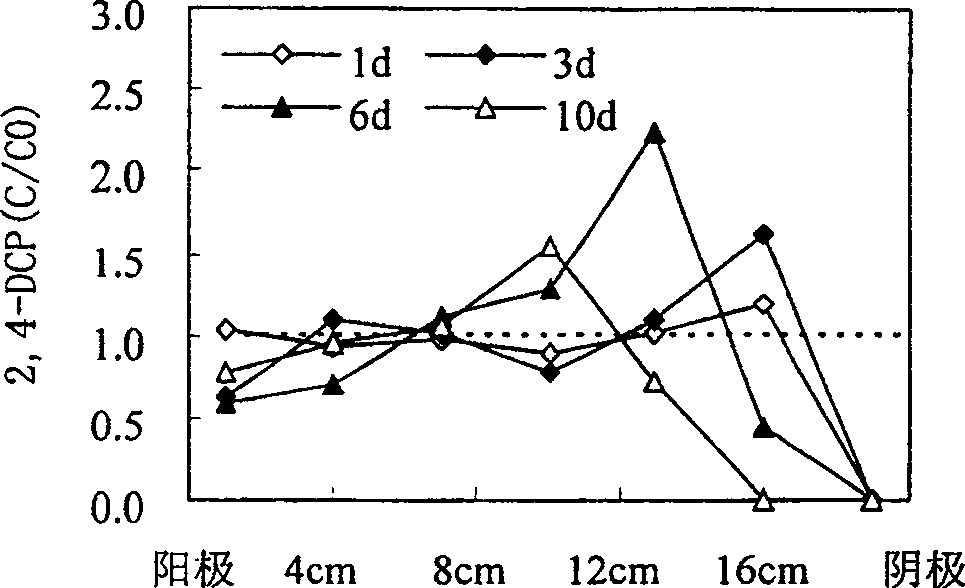Method for electrically and biologically rehabilitating soil adopting electrode matrix
An electrode matrix and electrokinetic biotechnology, applied in the restoration of polluted soil, etc., can solve the problems of low mass transfer rate, not yet involved in the field of in-situ bioremediation, inhibition, etc., and achieve the goal of strengthening the mass transfer process and improving the efficiency of bioremediation Effect
- Summary
- Abstract
- Description
- Claims
- Application Information
AI Technical Summary
Problems solved by technology
Method used
Image
Examples
Embodiment 1
[0031] Implementation example 1: enrichment of chlorophenols in soil
[0032] In the sandy loam layer, the moisture content is 17-19%. The initial concentration of 2,4-dichlorophenol was about 83mg / Kg dry soil, and a one-dimensional electrode configuration was used to apply a non-uniform electric field unidirectionally, with a voltage gradient of 1.0V / cm and an electrode spacing of 20cm. After the experiment, the concentration of 2,4-dichlorophenol was measured by sampling at different positions of the electrode pair connection. The chlorophenol in the soil sample was sent to high performance liquid chromatography for detection after three extractions with acetocyanide (the extraction rate reached 94.8%). The mobile phase consisted of methanol:5% glacial acetic acid aqueous solution=67:33, and the detection wavelength was 284nm.
[0033] image 3 It shows that when the test runs for 1 day, the content of 2,4-dichlorophenol at 1 cm away from the cathode has dropped to zero, w...
Embodiment 2
[0034] Implementation Example 2: Injection of Inorganic Nutrient Ion Nitrate
[0035]In the sandy loam layer, the water content is 17-19%, and NO is added in the fixed quartz sand area (C-r area) 3 - For ions, in a one-dimensional electrode configuration, a non-uniform electric field of 1.0V / cm is applied in one direction, and the electrode spacing is 100cm, and the experiment runs for 100 hours. A reaction system without voltage was used as a control. During the experiment, samples were taken every 10 hours, and the NO in different positions was measured by ion chromatography 3 - ion concentration.
[0036] Figure 4 Indicates that during 100 hours of one-way operation, NO 3 - The ions are constantly migrating towards the anode and diffuse throughout the soil area. After 80 hours, NO 3 - The ion concentration reached or was close to 1.4mg / Kg soil, while no NO was detected at the sampling point in the control experiment 3 - ions, which confirms the adoption of this...
Embodiment 3
[0037] Implementation Example 3: Injection of Phenol Efficient Degradation Bacteria
[0038] In the sterilized sandy loam layer, the moisture content is 17-19%. Add a high concentration of bacterial suspension in the quartz sand area (C-m area). In the one-dimensional electrode configuration, a non-uniform electric field of 1.0 V / cm was applied unidirectionally, the electrode spacing was 20 cm, and the experiment was run for 32 hours. A reaction system without voltage was used as a control. During the experiment, samples were taken to determine the number of live and dead bacteria in the soil samples. The soil samples were extracted by shaking with sodium pyrophosphate and counted. The number of live bacteria was counted by the plate technique (CFU), and the number of dead bacteria was stained with the Baclight LIVE / DEAD probe of Molecular Probes.
[0039] After 20 and 28 hours of operation, the bacterial concentration at a0 and c0 respectively reached the maximum value, bu...
PUM
 Login to View More
Login to View More Abstract
Description
Claims
Application Information
 Login to View More
Login to View More - R&D
- Intellectual Property
- Life Sciences
- Materials
- Tech Scout
- Unparalleled Data Quality
- Higher Quality Content
- 60% Fewer Hallucinations
Browse by: Latest US Patents, China's latest patents, Technical Efficacy Thesaurus, Application Domain, Technology Topic, Popular Technical Reports.
© 2025 PatSnap. All rights reserved.Legal|Privacy policy|Modern Slavery Act Transparency Statement|Sitemap|About US| Contact US: help@patsnap.com



